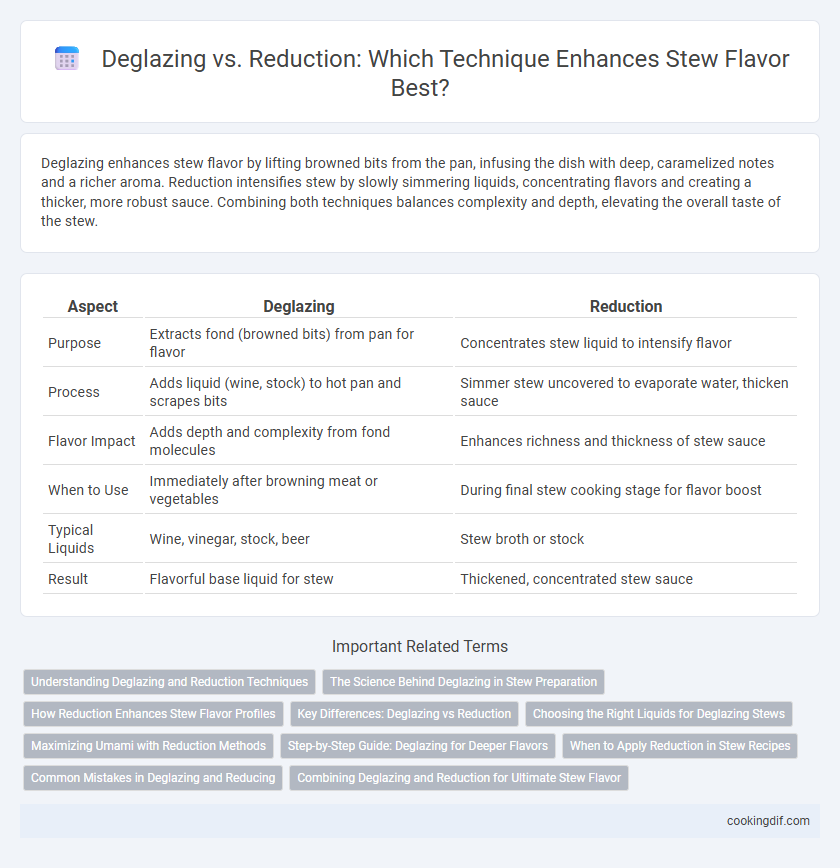Deglazing enhances stew flavor by lifting browned bits from the pan, infusing the dish with deep, caramelized notes and a richer aroma. Reduction intensifies stew by slowly simmering liquids, concentrating flavors and creating a thicker, more robust sauce. Combining both techniques balances complexity and depth, elevating the overall taste of the stew.
Table of Comparison
| Aspect | Deglazing | Reduction |
|---|---|---|
| Purpose | Extracts fond (browned bits) from pan for flavor | Concentrates stew liquid to intensify flavor |
| Process | Adds liquid (wine, stock) to hot pan and scrapes bits | Simmer stew uncovered to evaporate water, thicken sauce |
| Flavor Impact | Adds depth and complexity from fond molecules | Enhances richness and thickness of stew sauce |
| When to Use | Immediately after browning meat or vegetables | During final stew cooking stage for flavor boost |
| Typical Liquids | Wine, vinegar, stock, beer | Stew broth or stock |
| Result | Flavorful base liquid for stew | Thickened, concentrated stew sauce |
Understanding Deglazing and Reduction Techniques
Deglazing involves adding liquid to a hot pan to dissolve browned bits from cooking meat, enhancing stew flavor with rich, caramelized notes. Reduction focuses on simmering the stew liquid to concentrate flavors and thicken the consistency, intensifying the overall taste. Mastering deglazing and reduction techniques elevates stew depth by maximizing flavor extraction and achieving the perfect sauce texture.
The Science Behind Deglazing in Stew Preparation
Deglazing enhances stew flavor by dissolving browned food particles, known as fond, from the pan's surface, which are rich in Maillard reaction compounds that deepen taste complexity. The process involves adding a liquid, typically wine or stock, to the hot pan, releasing caramelized sugars and proteins that infuse the stew with intense savory notes. This contrasts with reduction, which concentrates flavor by evaporating liquid but does not capture the unique umami elements created during deglazing.
How Reduction Enhances Stew Flavor Profiles
Reduction intensifies stew flavor profiles by concentrating the natural ingredients and thickening the sauce through simmering, which deepens the richness and complexity of the dish. As water evaporates, the stew's savory compounds become more pronounced, enhancing the meat, vegetables, and herbs. This technique creates a balanced and robust flavor that elevates the overall taste experience.
Key Differences: Deglazing vs Reduction
Deglazing involves adding liquid such as wine, broth, or water to a hot pan to dissolve browned food residue, enhancing stew flavor through concentrated fond incorporation. Reduction focuses on simmering or boiling the stew liquid to evaporate water, intensifying flavor and thickening texture naturally. Key differences include deglazing recovering caramelized bits for complexity, while reduction deepens taste by concentrating existing stew liquids.
Choosing the Right Liquids for Deglazing Stews
Choosing the right liquids for deglazing stews significantly enhances flavor by dissolving browned bits from the pan, which are rich in umami. Wines, broths, and even strong teas release complex aromas and meld with the stew's ingredients, intensifying depth and richness. Careful selection of acidic liquids like wine or vinegar balances the reduction process, preventing bitterness while concentrating the flavors for a robust stew.
Maximizing Umami with Reduction Methods
Reducing a stew intensifies umami by concentrating flavors through evaporation, enhancing savory depth without added ingredients. Deglazing with wine, broth, or vinegar lifts fond from the pan, incorporating rich caramelized notes and contributing complexity. Combining deglazing and reduction methods maximizes flavor extraction, resulting in a robust, deeply savory stew.
Step-by-Step Guide: Deglazing for Deeper Flavors
Deglazing enhances stew flavor by dissolving browned bits from the pan with a liquid such as wine, broth, or vinegar, creating a rich base. Begin by removing cooked meat, then pour the deglazing liquid into the hot pan, scraping the fond with a wooden spoon to incorporate all caramelized residues. This step intensifies complexity and depth, elevating the stew's savory profile before slow simmering.
When to Apply Reduction in Stew Recipes
Reduction intensifies stew flavor by simmering to concentrate juices after initial cooking, ideal when a richer, deeper taste is desired. Apply reduction once all ingredients are tender and cooking liquids are combined, ensuring flavors meld without overcooking. Avoid early reduction to prevent toughening proteins and loss of moisture essential for stew texture.
Common Mistakes in Deglazing and Reducing
Common mistakes in deglazing stew include adding cold liquid too quickly, which can cause the fond to stick further and reduce flavor extraction, and using inappropriate liquids that overpower the stew's natural taste. In reduction, failing to control heat often leads to over-thickening or burning, resulting in bitter flavors that diminish the stew's richness. Both techniques require careful temperature management and timing to enhance depth and complexity without compromising balance.
Combining Deglazing and Reduction for Ultimate Stew Flavor
Combining deglazing and reduction enhances stew flavor by first lifting browned fond from the pan with liquid such as wine or broth, capturing intense umami notes. The subsequent reduction process concentrates these flavors by simmering the liquid, resulting in a rich, deeply layered sauce. This technique intensifies the stew's savoriness and ensures a balanced, robust taste profile.
Deglazing vs reduction for stew flavor Infographic

 cookingdif.com
cookingdif.com